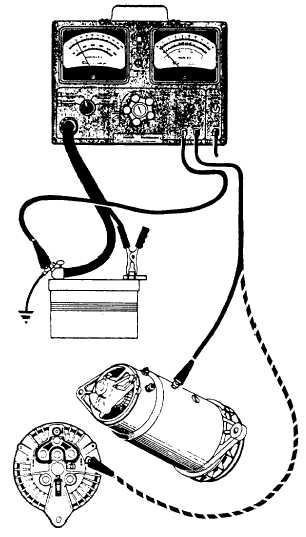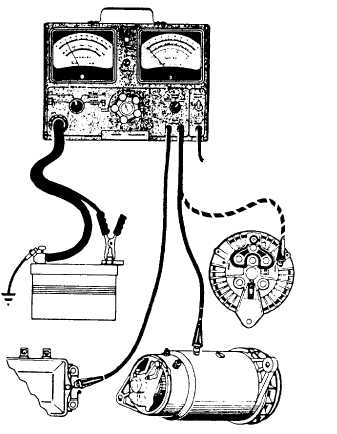CHARGING SYSTEM GROUND CIRCUITRESISTANCE TEST
When you conduct this test, observe polarity and connect the external volts lead to the generator or alternator ground terminal. (See fig. 4-13.) Then adjust the load increase knob until the ammeter scale indicates a current of 20 amperes for dc systems or 10 amperes for ac systems. Also, observe the voltage reading on the (3-volt) VOLTMETER scale and compare it with the specifications for proper charging system operation, as required by the vehicle manufacturer. If the reading is within specifications, you should proceed with a regulator ground circuit resistance test.

Figure 4-13.-Ground circuit resistance test.
REGULATOR GROUND CIRCUIT RESISTANCE TEST
To conduct this test, set the volt lead selector to the INT VOLTS position. Then, observing polarity, connect the external volts lead to the generator or alternator ground terminal and to the regulator ground terminal. (See fig. 4-14.) Adjust the load increase knob until the AMMETER scale indicates a current of 10 amperes. Also observe the reading on the (3-volt) VOLTMETER scale and compare it with the specifications. If the voltmeter reading exceeds 0.1 volt, excessive resistance is in the ground circuit between the regulator and the generator or alternator. Check the regulator ground system for loose mounting bolts or a damaged ground strap.
BATTERY DRAIN TEST
The purpose of this testis to determine if a discharge current is flowing when all accessories and lights are turned off. Any discharge at this time would indicate the presence of partially shorted or grounded wires,

Figure 4-14.-Regulator ground circuit resistance test.
Continue Reading